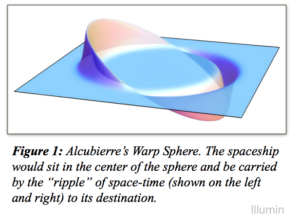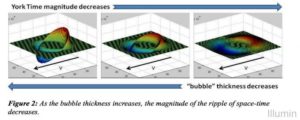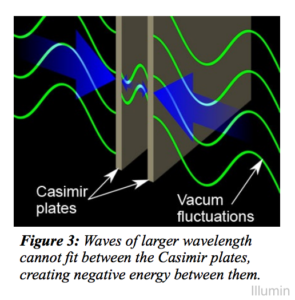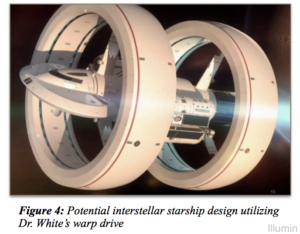Albert Einstein’s famous theory of relativity specified that the Universe had a speed limit for all masses. As a result, faster-than-light travel has always been seen as nothing more than science fiction. However, faster-than-light travel may not be so farfetched anymore. Engineers today are working to create the first usable ‘warp drive’, which would allow human beings to travel thousands of light years in the span of weeks or months. One might expect this implies we’ve figured out a way to be able to move faster than light itself, which seemingly contradicts Einstein’s theory. Shockingly though, the trick behind this feat lies not with creating a way to move faster to the location, but to move the location closer. This method requires digging deep into theoretical physics and making use of the very fabric of space and time. Should it be brought from theoretical to reality, the implications for space travel would be incalculable.
Introduction
For decades, novelists and scientists alike have imagined a futuristic world in which distant galaxies are only a few hours away. However, the whole idea of moving at the speeds to achieve that directly violates a number of physical laws. Star Trek, a 1966 science fiction show, illustrated this achievement through a device called a warp drive. Could the problem’s solution really be found in following a science fiction show?
The most fundamental of these aforementioned physical laws is Einstein’s theory of relativity, which set an ultimate speed limit for the universe [1]. Alpha Centauri, the next closest star after our own sun, is 24 trillion miles away. Even at light speed, such a trip would take generations. Todays’ theoretical physicists have, as a result, thought of intergalactic travel as something that will take at minimum years or decades, with technologies such as cryogenics being required to ever have man travel to a distant galaxy in a lifetime. The assumption behind these predictions involves trying to move with the highest attainable velocity and getting to the destination in a linear fashion. But as shows like Star Trek and other science fiction have suggested, what if we could just change the distance between our location and destination instead?
Alcubierre’s Metric
In 1994, the theoretical physicist Miguel Alcubierre proposed a mathematical model that would allow for faster-than-light travel [2]. This model was created to abide by Einstein’s field equations and general relativity, ensuring that it would not break the so-called “eleventh commandment” that “thou shalt not exceed the speed of light” [3]. Alcubierre thought that rather than traveling at a speed faster than light, why not instead contract the space between two objects, making travel appear to be faster than light, but in reality shorten the distance?
This is the essence of his proposal, which creates a contraction of space by creating a ripple in space-time in the shape of a bubble, as shown in figure 1 [2]. The center is where the traveling body would sit, which would travel at a normal speed under the speed of light, conforming to all the relativistic constraints placed upon it. However, in front of this warp sphere, space would contract (shown in fig. 1 as a deep crevasse on the right), reducing the distance. As a result, there is also an expansion of space behind the sphere (shown in Fig. 1 as a large peak). This crevasse and peak would ripple outwards in space, creating the wave on which the spacecraft would ride to its destination light years away. The spacecraft would literally ride the effects of manipulating the fabric of space.
Initially, this seems to contradict Einstein’s speed limit as the wave itself would have to be faster than the speed of light. However, this wave is a ripple in space-time, whereas Einstein’s universal speed limit applies only to space-time itself. Alcubierre essentially proposed a way to modify the very fabric of space-time in order to allow for faster-than-light travel.

While the math behind his theory has been verified and remains sound to this day, a near-infinite level of negative energy would be required. Just the science behind such power would require a deep knowledge of theoretical physics. Due to both of these requirements, Alcubierre’s model has been thought to be impossible to achieve in reality until just as recently as a few years ago.
From Theory to Reality
In 2011, Dr. Harold White published an article through NASA entitled “Warp Field Mechanics 101” [4]. In this document, White revealed his new method for engineering Alcubierre’s warp bubbles that would be possible with today’s technology, along with his method for testing for their existence.
Dr. White’s solution to the near infinite energy required to create a “proper” warp bubble is simple: change the shape of the bubble. For example, in Alcubierre’s equations, when the energy put into the bubble is decreased to a certain level, the thickness of the bubble around the sphere is increased until it folds into itself, creating the donut shape shown in the right image of Fig. 2. This requires substantially less energy, but the size of the ripple in space-time, referred to by White as York Time, is also reduced. This reduction of the space time ripple makes travel times much slower than they would be in the case of a spherical warp according to the proof. Luckily, Dr. White finds that this change in speed is negligible, as his simulations have found that the warp donut would still be capable of travel to Alpha Centauri in a mere forty days, a vast improvement over the lifetimes it would have taken before.

Along with decreasing the energy required to generate a warp field, the problem of manufacturing negative energy has been solved with the recent discovery of the Casimir Effect and antimatter for small and large scale warps, respectively.
The Casimir Effect is a phenomenon that occurs when two parallel plates in a vacuum are placed in close proximity with each other. Ambient waves, such as UV radiation from the sun, permeate the vacuum, but the plates are so close together that large wavelengths can no longer fit between the plates (seen in Fig. 3) [5]. This in turn creates a net negative energy between the plates relative to the vacuum around it. While this method has been applied in laboratories before, it is only practical on an incredibly small scale due to the close proximity that the plates must be placed to each other and required energies to do so.

For the larger-scale negative energy generation, antimatter is a new possibility. Whereas normal matter has positive energy associated with it, antimatter has negative energy, meaning that an antimatter reaction would release this negative energy [6]. While antimatter has not yet been used to generate the large amounts of energy necessary for interstellar travel, as currently only small quantities exist in laboratories, in the future it is easily foreseeable that antimatter could be used to create the necessary energy to power a large-scale warp bubble.
With this simple change in the warp field’s shape and the discovery of a new ways to create negative energy, warp drives are now within the realm of possibility for human beings. Concept designs have even begun appearing, including the recent design for an interstellar spacecraft created by artist Mark Rademaker (shown in Fig. 4) [7]. This design employs two rings to generate a warp field in an elliptical shape, conserving as much space, and therefore energy, as possible.

Besides engineering theoretical warp drive systems, Dr. White is also working with NASA’s Eagleworks Lab to test if these warp fields can be created in the first place. A small scale warp field has been designed by NASA and Dr. White which generates the necessary energy to create a one centimeter diameter warp donut. While the specific details of this device are classified as a government secret, Dr. White hints in his own journal article that it could be as simple as “a very high-voltage capacitor ring” [4]. This points towards an applied use of the Casimir Effect previously discussed, which has been created on a similar scale in several different laboratories since the late 1980’s. While the device itself appears to be simple in design, without a large enough space to measure a warp from inside the bubble, the challenge arises as to how to measure the presence of this warp field.
To detect the presence of the warp field, the experiment that Dr. White is currently undertaking utilizes a modified Michelson-Morely interferometer, named the White-Juday Warp Field Interferometer (pictured in Fig. 5). This device utilizes a specialized laser which is split at the center of the device. One beam of light travels directly to a mirror:

The “toroid capacitor ring” is the warp field generator, most likely utilizing the Casimir Effect for energy. And then back down into a detector, while the other passes through the warp sphere generator then is reflected back into the detector. If the warp generator is off, the beams should arrive at exactly the same moment, proving that distance is equal between the two mirrors. However, if the warp generator is turned on, one of the beams should be shifted slightly, as the distance inside the warp sphere is now different than the distance between the empty air the other beam travels through. By measuring this change of distance, Dr. White and his team hopes to prove that warp fields can be successfully generated on a small scale.
Will it work?
In the twenty years since Alcubierre first published his metric for creating a warp drive, several theoretical physicists have found problems posed by the technology.
Chief among them is the unknown direction that the spacecraft will take. Alcubierre’s formula does not take into account the sign of the direction that the ripple of space-time would travel in, meaning that potentially any travel using the warp drive could go away from instead of towards its target [8]. Dr. White has foreseen this problem, finding that this should be obtainable by transforming Alcubierre’s original formula and then using a standard trigonometric identity to solve for the angle, which in this case would either be zero degrees for straight forward or 180 degrees for straight backwards.
Another problem facing this project is generating large amounts of negative energy to power the warp bubble. Physicist Sean Carrol, in an interview, analyzed how expensive the antimatter fuel would cost given Dr. White’s current designs. He found that “fuel alone will cost you $3.5 quadrillion — roughly the entire economic output of the world for forty years” [9]. While for the time being this is true, antimatter fuel costs are sure to decrease as methods to create it become more refined. Much like any cutting-edge technology, costs decrease rapidly as the technology becomes better understood and improved upon. For now though, the price of fuel remains the largest potential obstacle for interstellar travel.
Conclusion
If Alcubierre’s mathematical model holds true in real life, one day soon everyday travel could be transformed from between cities and countries to between planets and galaxies. While not fully realized yet, Dr. White’s research has the potential to change the scope of where humanity can exist forever, with interstellar travel being possible well within our lifetimes. Nuclear energy started as just a theory that many believed would never come to fruition and a clean energy source was often featured in science fiction. Now not even a century later nuclear energy powers millions of homes around the globe. While the challenges are many and there is a potential for failure, warp drive technology is no longer merely in the realm of science fiction. One day the light-speed barrier may well be broken by humanity, and this day may be just months or years away.
References
- [1] A. Jha. (2014, January 12). Why you can’t travel at the speed of light: A short history of Einstein’s theory of relativity [Online]. Available: http://www.theguardian.com/science/2014/jan/ 12/einstein-theory-of-relativity-speed-of-light
- [2] J. G. Cramer. (1996, November). The Alcubierre Warp Drive [Online]. Available: http:// www.npl.washington.edu/AV/altvw81.html
- [3] D. Hakim. (2013, July 22). Faster Than the Speed of Light? [Online]. Available: http:// www.nytimes.com/2013/07/23/science/faster-than-the-speed-of-light.html? pagewanted=all&_r=0
- [4] S. White. (2011). Warp Field Mechanics 101 [Online]. Available: http://ntrs.nasa.gov/archive/ nasa/casi.ntrs.nasa.gov/20110015936.pdf
- [5] S. Reucroft and J. Swain. (1998, June 22). What is the Casimir Effect? [Online]. Available: http://www.scientificamerican.com/article/what-is-the-casimir-effec/
- [6] R. M. Barnett and H. Quinn. (2002, January 24). What is antimatter? [Online]. Available: http://www.scientificamerican.com/article/what-is-antimatter-2002-01-24/
- [7] C. Schmidt. (2014, June 12). What an Enterprise! NASA physicist, artist unveil warp-speed craft design [Online]. Available: http://edition.cnn.com/2014/06/12/tech/innovation/warp-speed- spaceship/
- [8] J. Natario, “Warp drive with zero expansion,” Classical and Quantum Gravity, vol. 19, no. 6, pp. 1157-1166, 2002.
- [9] J. Torchinsky. (2014, June 23). The Painful Truth About NASA’s Warp Drive Spaceship From A Physicist [Online]. Available: http://jalopnik.com/the-painful-truth-about-nasas-warp-drive- spaceship-from-1590330763


